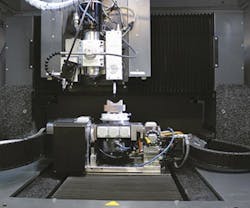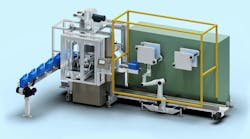Kugler of America has added a function to its MicroMaster hydrostatic five-axis machining center that allows it to efficiently produce optical features in molds and mold inserts, Kugler GM Meinrad Schirmeister said. Molds with such features are used to injection mold optical components for automotive headlights and interior displays, as well as LED flashlights and other consumer products.
Often, molds and mold inserts used to make optical components are made from brass, nickel- silver, a high-strength aluminum alloy or steel that has been chemically plated with nickel. If the tooling is made of hardened mold steel, the metal must be milled, ground and/or eroded and then polished until the surface meets the optical specifications, Schirmeister said.
The inherent problem with using hardened steel is the loss of geometrical form accuracy due to polishing, Schirmeister said. Often the polishing — either done by hand or through an automated process — can considerably affect surface features, whether they are elevated or submerged micro structures. Polishing is used to achieve a desired optical finish, but the sacrifice is that the actual surface features can be destroyed, Schirmeister said.
Alternatively, mold makers can use a monocrystalline diamond tool to machine an optical feature directly into a mold or mold insert made of brass, nickel-silver, high-strength aluminum alloy or chemically nickel-plated steel mold, Schirmeister said. The polishing step is eliminated when diamond machining is used, although the service life of the mold is shorter compared with a hardened steel mold, he said.
Kugler developed an approach whereby its machining center can diamond machine an optical feature directly into a hardened steel mold, which eliminates the need for polishing and milling, yet overcomes an issue with short tool life of the diamond tool.
The greatest impediment to using a diamond tool for machining of hardened tool steel is the short life of the diamond tool due to bonding. "Diamond is basically comprised of carbon, and the carbon within it is prone to bonding with the iron in the hardened steel. The result is iron carbide," Schirmeister said. The high temperatures allow the diamond tool to react with the iron in the steel. "Hence, the diamond tool has an extremely short service life when machining hardened steel," he said.
ADOPTING ULTRASONIC-ASSISTED MACHINING
There are different approaches to tackling the problem. For example, the processing zone can be cooled with liquid nitrogen, but this approach is complicated and dangerous. "The process has not yet been used in industry," he said.
Kugler has adopted an ultrasonic-assisted diamond machining method to solve the issues. Until now, the method has been used mainly for diamond turning on ultra-precision turning machines. With ultrasonic-assisted diamond machining, the diamond cutting tool is made to vibrate at high frequencies, and is pushed in an elliptical motion.
"The short frequency of the vibrations prevents the carbon in the diamond tool from bonding to the iron, due to the minimal exposure time," Schirmeister said. Due to the extremely short exposure time, the temperature at the cutting edge remains low enough to prevent the chemical bonding of the carbon and the iron and maintains the integrity of the cutting tool. The ultrasonic method avoids carbon buildup on the diamond cutting edges, he said.
Kugler said the life expectancy of the diamond tool depends on cutting parameters and other factors, but generally it will be the same as a diamond tool in a standard (non-hardened steel) machining application. Until now, hardened steel machining was limited to micro-machining with conventional micro-machining tools rather than diamond cutting tools, Schirmeister said.
Ultrasonic-assisted diamond machining is the newest capability of the MicroMaster system, which has a modular design, so that up to three application heads can be installed side by side. This allows it to perform multiple machining steps, such as mechanical micro milling and laser micro milling.
The ultrasonic-assisted diamond cutting tool can leave slight surface irregularities that are easily corrected with light polishing. "In this case, virtually no change in the surface shape occurs," Schirmeister said.
Mikell Knights, senior staff reporter
Contact:
Kugler of America Ltd.,Somers, Conn., 860-749-6400, www.kuglerofamerica.com






